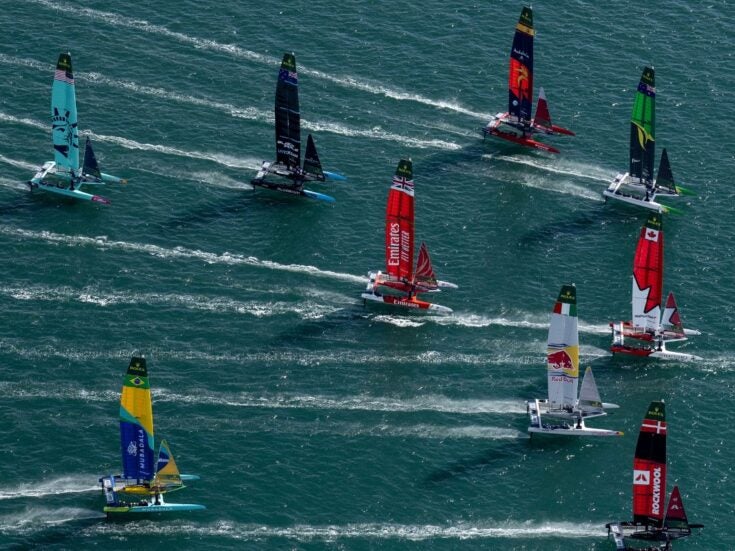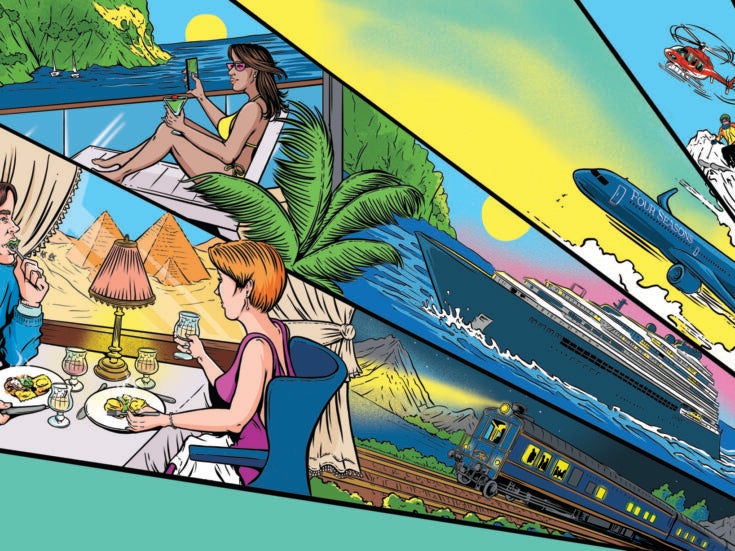
Hidden Gem
An elegant Tasmanian eco-lodge, Saffire is shown off to perfection in a magnificent setting — even if the table service could do with a tad more polish, says Josh Spero
DRIVING THROUGH TASMANIA, I felt like one of the impious left behind after Judgment Day (a highly likely scenario). I drove for miles in my throwback Hyundai, through deserted villages in bright afternoon light, above placid lakes, along narrow single carriageways which hugged zigzagging mountainsides packed with Tasmanian blue gum trees, with their twisted and peeling pale barks. Plentiful roadkill was unfortunate evidence of other drivers, but in my two and a half hours from Hobart to Saffire, I hardly saw another car.
And this is the habitable eastern side of Tasmania, where the land is flatter, crossable by roads and not covered in rainforest, like the still-mysterious western half, with its occasional snowy peaks and massive national parks. Still, even inhabited Tasmania is empty Tasmania. The coastal route to Saffire along the Tasman Sea afforded glimpses of beaches through the trees, New Zealand an invisible thousand miles away, and I pleasurably prolonged my journey by wheeling round into a lay-by to get out and clamber down some rocks on to a few of those beaches.
When I arrived at Saffire it was evening, but being mid-December in the southern hemisphere, the watery grey and yellow of the afternoon was only grudgingly giving way to night, and by the time I sat down for dinner at 9pm, the sky still had a few orange streaks and a metal glitter. (The food was not quite as glittering, but we can come back to that.) I could catch a few final glimpses of the grounds, whose very careful landscaping lies in the impression that no landscaping has been done at all. Before Saffire opened in 2010, the land had been a concrete caravan park; during construction, 35,000 indigenous plants were added. Wild grasses now blow fitfully in the wind.
Australia has not properly capitalised on the bounty of its scenery in the luxury hotel market. Largely, no doubt, this is a circuitous problem created by distance debarring many travellers from unfamiliar areas and stymieing new developments, in turn turning off new travellers by lack of supply. The expensive Australian dollar is not helping either.
These excuses are all the more troubling when you visit one of the few luxury resorts, such as Saffire, which has a swooping Circa Architecture building with a three-storey glass window overlooking the suites, discreetly laid out in a low sweep between the main building and Oyster Bay. The main building, in tones of brown and grey, sits naturally within the landscape, its granite and sandstone tiles, the kilometres of celery top pine all subtly bringing the outdoors in.
Saffire cannot be accused of not recognising its chief asset: in your suite, the entire back wall is covered in blackout blinds. With a tap on the control panel, all start whirring up at once, revealing an entirely glass wall overlooking low trees, a crescent of the bay beyond and pink granite cliffs furthest off. Morning light floods the room, and it’s a complete coup de théâtre.

I only saw my room a while after arriving because, as I was being led out of the main building to the row of suites, a woman rushed by in a desperate search for cleaning equipment and told the manager escorting me that my room would be some time. A cleaner’s trolley headed towards my room, too. There was no sign of this emergency operation finishing any time soon, so I was given another suite. The next morning, the same manager apologised and said there had been a small problem. ‘Burst sewage pipe?’ She nodded.
DINNER BECKONED WHILE the suite was made up. Hugh Whitehouse is the ‘culinary master’ of Saffire and seemed to have assimilated the most modern of techniques into a repertoire heavy on the local produce on which Tasmania prides itself. A starter of beetroot three ways was a visual feast. The main course was chicken sous-vide, where it is cooked in a vacuum at a low temperature to retain its flavours and tenderness. All I can say is that if it had retained all its flavours by the time it ended up on my plate, it was a bland bird to begin with. The white asparagus was bland. Even the garlic custard was bland. When the waiter came over to see if everything was okay and I carefully mentioned that it had not been, he said: ‘I’m sorry you couldn’t appreciate that, sir.’
The next morning, after uninsultedly enjoying a breakfast of poached peaches, Tasmanian berries and hotcakes with ricotta (thick pancakes), it was time for the other thing Saffire boasts about itself: experiences which make best use of the bay Saffire sits on, the granite mountains across the bay and the Freycinet National Park which rests on these mountains.
For a place regarded as backwards by the rest of Australia, Tasmania is certainly fashion-forward: the ankle-length waterproof jacket I had to put on before our boat trip would have got rave reviews in Dalston. The normal route for this boat is down the western side of the peninsula occupied by the national park, around its tip and then up its eastern coast to Wineglass Bay, so called — in one account — because of the red colour the water turned during whale-hunting season. (This industry was stimulated by British demand for their fat, which burned cleanly in streetlamps. Damn Victorians!)

The rough conditions weighed against this, so once we passed the tip, we circled around Schouten Island, a severe orange citadel rising from the blue, whose stark cliffs bear broad bands of lichen in black and bright green. Off the southern tip of Schouten Island are two small but steep islands, also in the rich pinky-orange granite that dominates. One of these islands has a low ledge, white with seal shit, on which the seals — who have the daft air and lumber of a rather stupid St Bernard — sit and squawk. As we watched, one slid effortlessly yet gracelessly into the water, prompting a gasp from a fellow passenger imagining how cold it was.
BY NOW, THE winds were churning up the waters and I, sitting nearest to the rail, was repeatedly slapped in the face by spray, as if Neptune had taken against something I’d said. The person next to me — a blonde lady of a certain age and a certain degree of wealth — chatted about her philanthropic activities and her horticultural passions; she was mad for the Chelsea Flower Show, displaying that strong Australian anglophile streak. (My trusty faded green Daunt Books bag went down a storm everywhere.)
On a walking tour the next day around the Freycinet National Park, with views of dolphins in the distance and a visit to a soft beach enclosed by high rocks and trees, I was with a youngish couple who collected Modern Australian art; the husband had been a senior adviser at the World Bank. We traded gloomy financial predictions. I say ‘gloomy’ — he was quite pleased to be in Australia, reckoning it and Canada the only safe havens today.
The clientele at Saffire is largely wealthy Australian honeymooners, anniversary-celebrators and those hitting a new decade, and the hotel’s ambition of having 20 per cent from abroad last year was in part scotched by the high dollar. Equally, I imagine, Tasmania is terra incognita for most today as it was until the 18th century (from a European perspective only, of course); visiting it, then, is a gamble. Yet it is precisely the spirit of adventure that would take you to Tasmania that will be satisfied once there, according to Matt Casey, Saffire’s general manager. He says the achievement that comes from adventure, whether it’s sailing out into the Tasman Sea or trekking to hidden coves, is what he thinks guests enjoy most.

When you’re not being adventurous, there is certainly a contemplative mood that can settle over you. The permanence of the granite cliffs, the endlessness of the sea conspire. A few people remarked to me about Tasmania’s ‘dark heart’, the history of slaughter the Europeans brought, but they also talked about the success of those who came unwillingly to this distant place, the 75,000 convicts transported over two decades in the 19th century. The adventure Saffire provides is perhaps not on this scale, but as a hotel with the potential for greatness, it is a fine mark in an adventurous landscape.
Photographs courtesy Luxury Lodges of Australia
Despatch From 35,000 Feet
When travelling, I measure comfort on my babyometer scale: if there is a baby and it is crying, I am uncomfortable. One of the most common causes of this is the droning volume of a plane’s engines, which is why my business flight on Qantas’s quiet A380 to Australia scored so well on the babyometer. Not even those newborn sonic Geiger counters detected anything, nor did any engine noise disturb my kip on the flatbed, on which, of course, I slept like a baby.
During the conscious hours, while I was amusing myself with Midnight in Paris and crying through Beginners, I also enjoyed chef Neil Perry’s offerings. I got in the mood for my three hours in Singapore with Asian consommé with prawn wontons and, feeling unusually healthful, decided that the plentiful fruit would serve well.
On the way back, I regret to say I indulged. One of the liberalities for Business clients is the endless supply of food: delicate master stock chicken cooked in the traditional Chinese style, Amedei dark chocolates, seasonal cheeses (‘local cheeses’ would be an odd concept for long haul), more fruit and plenty more water (for the skin, you see).
Perry has said his Qantas food draws on international restaurants for its inspirations, and all I can say is you won’t go wrong booking one of his tables up in the troposphere.
Josh Spero is Spear’s editor







